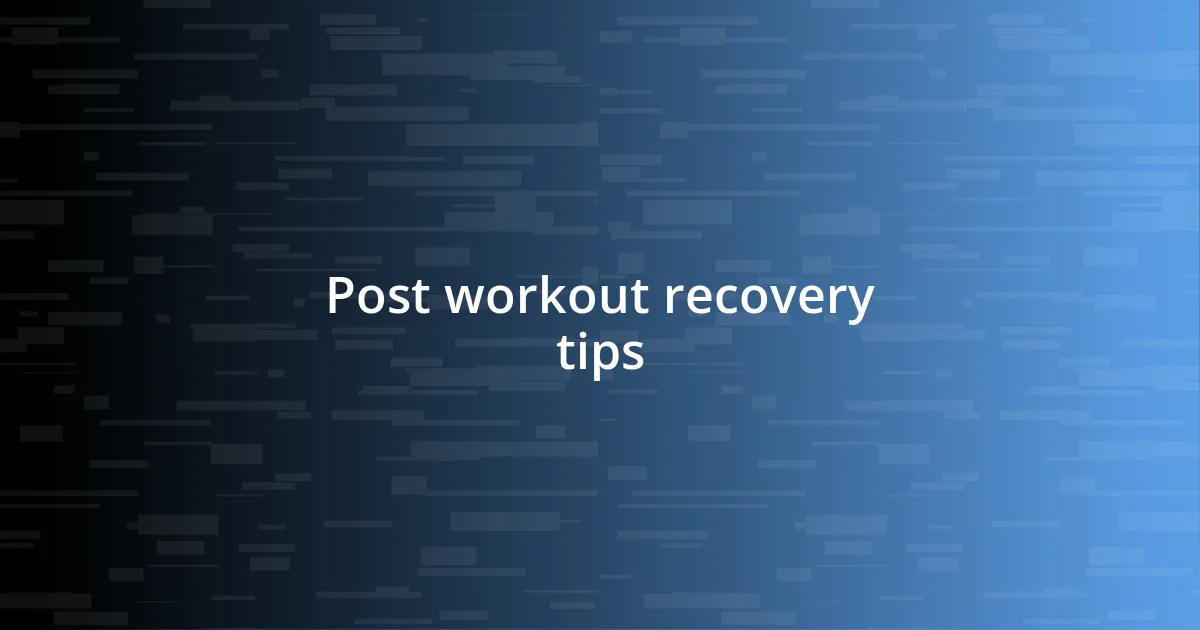Key takeaways:
- Hydration and electrolyte balance are crucial for recovery post-workout; methods include water, electrolyte drinks, and coconut water.
- Nutritional needs should be addressed promptly after exercise, focusing on a balanced intake of proteins, complex carbs, healthy fats, and fruits.
- Incorporating recovery tools like foam rollers, compression gear, and scheduling regular recovery days enhances overall recovery and performance.

Post workout recovery tips
After an intense workout, I find that hydration is absolutely essential. I remember a time when I overlooked this basic principle; my body felt heavy and sluggish afterward. Now, I always make a point to drink water and even toss in a pinch of salt for those long sessions; it really makes a noticeable difference.
I can’t stress enough the importance of stretching post-workout. There was a period when I pushed myself to the max without taking time to properly cool down, and I ended up nursing some pretty nasty muscle soreness. Incorporating deep, gentle stretches not only feels good but also helps my muscles recover faster. When was the last time you took a few minutes just to breathe and stretch? You might be surprised at how much better you feel.
Another key recovery tip I’ve learned over the years is to refuel wisely. I often prepare a protein-packed smoothie with fruits and greens right after my sessions. I’ve found that prioritizing nutrients helps my body recover and provides me with energy for the day ahead. So, what’s your go-to post-workout snack? Finding what works for you can transform your recovery experience!

Importance of hydration after exercise
Hydration plays a critical role after exercise. I still vividly remember finishing one particularly tough run without rehydrating properly. I felt disoriented and craved water like it was my lifeline. Drinking fluids after intense activity helps replenish lost electrolytes and supports overall recovery, which is something I never skimp on anymore.
It’s fascinating how our bodies work. During workouts, especially intense ones, we lose a substantial amount of water through sweat. I realized that just chugging water isn’t enough; I also need to be mindful of electrolytes. For me, adding a pinch of salt to my drink or opting for an electrolyte-infused beverage makes all the difference, restoring balance and ensuring I feel energized instead of drained.
On tough workout days, I’ve adopted a habit of keeping a water bottle nearby at all times. It’s become a comforting ritual—taking little sips throughout the day reminds me to stay hydrated. This simple act has improved my endurance in workouts and overall well-being. Have you ever thought about how hydration can enhance your performance? I’ve seen the impact firsthand, and it’s profound.
| Hydration Method | Benefits |
|---|---|
| Water | Replenishes lost fluids quickly and keeps joints lubricated. |
| Electrolyte Drinks | Restores essential minerals lost in sweat, improving recovery time. |
| Coconut Water | Natural source of hydration with added potassium and nutrients. |
| Smoothies | Combines hydration with nutrients for energy and recovery support. |

Nutritional needs after intense workouts
After an intense workout, addressing nutritional needs becomes crucial for my recovery. I recall one day, completely exhausted after a grueling cross-training session; I opted for just a granola bar instead of a balanced meal. I ended up feeling depleted and sluggish. Now, I make it a priority to consume a blend of proteins and carbs within 30 minutes. I’ve noticed how proper nutrition not only aids my recovery but also boosts my mood and energy levels.
What I find works best for me includes:
- Lean Proteins: Chicken, turkey, or plant-based options like lentils help repair muscles.
- Complex Carbs: Quinoa, sweet potatoes, or brown rice replenish glycogen stores and provide lasting energy.
- Healthy Fats: Avocados or nuts support overall nutrition and aid in inflammation reduction.
- Fruits: Bananas or berries offer quick carbs along with essential vitamins that help reduce muscle soreness.
I’ve learned that these nutritional choices make a significant difference in how I feel post-workout. It’s like fueling my body with exactly what it craves!

Best stretching practices after exercising
When it comes to stretching after a tough workout, I’ve found that focusing on the major muscle groups is key. I remember finishing a challenging leg day and feeling tight all over. I sat down and spent a good 10 minutes on deep stretches like hamstring stretches and quad pulls. It was almost like a reset button for my muscles—what a relief! Have you ever felt that tension melt away as you ease into a good stretch? It’s almost meditative for me.
Incorporating static stretches holds specific benefits. Holding each stretch for 20 to 30 seconds helps my muscles relax and regain length. I try to breathe deeply through each stretch, and I can honestly say it makes a difference. I often pair this with gentle movements like side bends or torso twists to engage my core, and somehow it makes the whole process feel more complete.
Now, I can’t stress enough the importance of listening to my body during stretching. If I ever feel a pinch or discomfort, I back off and adjust—no need to push through pain. One time, I ignored a tight spot in my shoulder thinking it would loosen up, but instead, it led to soreness for days. Since then, I always pay attention and adapt my stretches to how I feel that day. It’s about balance, right? Isn’t it rewarding to discover what truly works for your own body?

Mental strategies for post workout fatigue
After a tough workout, I often find my mind racing with thoughts about what I could have done differently. To combat this, I’ve embraced mindfulness techniques. One particular evening, following a high-intensity session, I took a few minutes to sit in a quiet space and focus on my breath. It was incredible how much clarity this simple practice offered—suddenly, I could appreciate my effort instead of dwelling on fatigue. Have you ever noticed how a moment of stillness can turn your perspective around?
When feelings of fatigue begin to set in, I remind myself to employ positive affirmations. It’s fascinating how a few affirming words, like “You’ve worked hard today” or “You are stronger than your tiredness,” can shift my mindset. I vividly recall moments where I felt mentally drained, yet reciting these phrases helped reignite my motivation. It’s like having a little pep talk with myself; how do you lift your spirits when you hit that wall?
Finally, I’ve found making a gratitude list right after working out shifts my focus away from fatigue. Reflecting on what I’m thankful for—from completing a tough workout to having supportive friends—helps me feel accomplished. I remember a day when I wrote down the smallest victories, like finishing my workout and enjoying a refreshing shower. Each item made me realize that mental fatigue doesn’t overshadow the successes I’ve achieved. Doesn’t it feel refreshing to celebrate every step, no matter how small?

Tools to aid workout recovery
After an intense workout, I’ve discovered that certain tools can significantly aid my recovery. One of my favorites is a foam roller. I remember the first time I used one after a grueling spin class; the feeling of rolling out tight muscles was nothing short of blissful. I often focus on my quads and calves, which tend to be the tightest for me. Have you ever tried foam rolling? It can feel uncomfortable at first, but the relief is well worth it.
Beyond massage tools, I advocate for using compression gear during recovery. A couple of weeks ago, I donned my compression sleeves right after an intense weightlifting session. It helped promote blood flow and reduce swelling in my legs. I swear it felt like I was wrapping my muscles in a comforting hug. When I wear them, I often notice that my post-workout soreness diminishes much faster. Have you considered incorporating compression gear into your routine? It’s a game-changer for many.
Hydration is another crucial element in my recovery toolkit. I remember a particularly tough session where I didn’t hydrate adequately afterward; the headache that followed was a vivid reminder of my oversight. Now, I make it a point to sip water or an electrolyte drink as soon as I finish exercising. It’s essential for replenishing lost fluids and helping my body bounce back. How do you choose to hydrate after your workouts? I’ve learned it’s one of the simplest yet most effective ways to feel rejuvenated!

Building a long term recovery plan
Building a long-term recovery plan requires thoughtful consideration of various recovery strategies that work for you. I’ve personally found that scheduling recovery days is vital. For instance, after I’ve pushed myself in an intense training cycle, I dedicate one day a week solely to recovery activities, such as yoga or leisurely walks. This not only gives my body time to heal but also helps clear my mental fog. Have you experienced the benefits of just slowing down your workout schedule?
Incorporating nutrition into my recovery plan has also been a game changer. I remember the first time I started meal prepping post-workout meals rich in protein and healthy fats. Not only did I notice an improvement in how quickly I bounced back, but I also felt more energized for my next workout. It’s fascinating how the right nutrients can fuel recovery—what do you typically reach for after a sweat session? You might be surprised at how much food can influence your long-term progress.
Lastly, I’ve learned that tracking my recovery progress can lead to valuable insights. I keep a journal that includes how I feel after workouts, what recovery strategies I’ve used, and the outcomes. There’s something empowering about recognizing patterns and adjusting accordingly. Just last month, I discovered that stretching extensively helped my performance days later. Have you ever considered how simple notes could enhance your routine? It’s amazing what awareness can do for your recovery journey.














